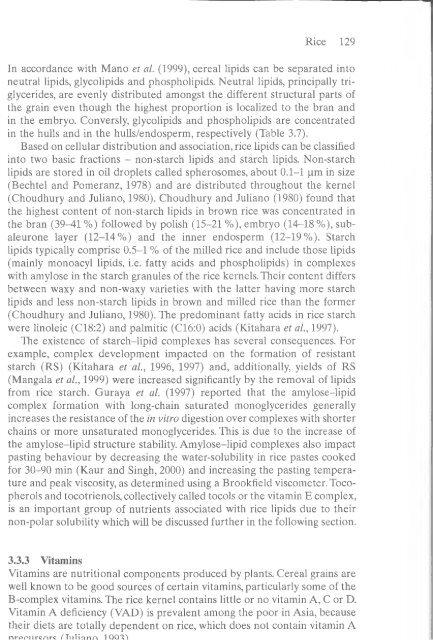Arendt und Zannini - 2013 - Cereal grains for the food and beverage industries
Arendt und Zannini - 2013 - Cereal grains for the food and beverage industries
Arendt und Zannini - 2013 - Cereal grains for the food and beverage industries
Create successful ePaper yourself
Turn your PDF publications into a flip-book with our unique Google optimized e-Paper software.
nrf^r*iircr\rc /"Tiilicinn 1 QQ'^^<br />
Rice 129<br />
In accordance with Mano et al. (1999), cereal lipids can be separated into<br />
neutral lipids, glycolipids <strong>and</strong> phospholipids. Neutral lipids, principally triglycerides,<br />
are evenly distributed amongst <strong>the</strong> different structural parts of<br />
<strong>the</strong> grain even though <strong>the</strong> highest proportion is localized to <strong>the</strong> bran <strong>and</strong><br />
in <strong>the</strong> embryo. Conversly, glycolipids <strong>and</strong> phospholipids are concentrated<br />
in <strong>the</strong> hulls <strong>and</strong> in <strong>the</strong> hulls/endosperm, respectively (Table 3.7).<br />
Based on cellular distribution <strong>and</strong> association, rice lipids can be classified<br />
into two basic fractions - non-starch lipids <strong>and</strong> starch lipids. Non-starch<br />
lipids are stored in oil droplets called spherosomes, about 0.1-1 pm in size<br />
(Bechtel <strong>and</strong> Pomeranz, 1978) <strong>and</strong> are distributed throughout <strong>the</strong> kernel<br />
(Choudhury <strong>and</strong> Juliano, 1980). Choudhury <strong>and</strong> Juliano (1980) fo<strong>und</strong> that<br />
<strong>the</strong> highest content of non-starch lipids in brown rice was concentrated in<br />
<strong>the</strong> bran (39-41 %) followed by polish (15-21 %), embryo (14-18%), subaleurone<br />
layer (12-14%) <strong>and</strong> <strong>the</strong> inner endosperm (12-19%). Starch<br />
lipids typically comprise 0.5-1 % of <strong>the</strong> milled rice <strong>and</strong> include those lipids<br />
(mainly monoacyl lipids, i.e. fatty acids <strong>and</strong> phospholipids) in complexes<br />
with amylose in <strong>the</strong> starch granules of <strong>the</strong> rice kernels. Their content differs<br />
between waxy <strong>and</strong> non-waxy varieties with <strong>the</strong> latter having more starch<br />
lipids <strong>and</strong> less non-starch lipids in brown <strong>and</strong> milled rice than <strong>the</strong> <strong>for</strong>mer<br />
(Choudhury <strong>and</strong> Juliano, 1980). The predominant fatty acids in rice starch<br />
were linoleic (C18:2) <strong>and</strong> palmitic (C16:0) acids (Kitahara et al., 1997).<br />
The existence of starch-lipid complexes has several consequences. For<br />
example, complex development impacted on <strong>the</strong> <strong>for</strong>mation of resistant<br />
starch (RS) (Kitahara et al., 1996, 1997) <strong>and</strong>, additionally, yields of RS<br />
(Mangala et al., 1999) were increased significantly by <strong>the</strong> removal of lipids<br />
from rice starch. Guraya et al. (1997) reported that <strong>the</strong> amylose-lipid<br />
complex <strong>for</strong>mation with long-chain saturated monoglycerides generally<br />
increases <strong>the</strong> resistance of <strong>the</strong> in vitro digestion over complexes with shorter<br />
chains or more unsaturated monoglycerides. This is due to <strong>the</strong> increase of<br />
<strong>the</strong> amylose-lipid structure stability. Amylose-lipid complexes also impact<br />
pasting behaviour by decreasing <strong>the</strong> water-solubility in rice pastes cooked<br />
<strong>for</strong> 30-90 min (Kaur <strong>and</strong> Singh, 2000) <strong>and</strong> increasing <strong>the</strong> pasting temperature<br />
<strong>and</strong> peak viscosity, as determined using a Brookfield viscometer. Tocopherols<br />
<strong>and</strong> tocotrienols, collectively called tocols or <strong>the</strong> vitamin E complex,<br />
is an important group of nutrients associated with rice lipids due to <strong>the</strong>ir<br />
non-polar solubility which will be discussed fur<strong>the</strong>r in <strong>the</strong> following section.<br />
3.3.3 Vitamins<br />
Vitamins are nutritional components produced by plants. <strong>Cereal</strong> <strong>grains</strong> are<br />
well known to be good sources of certain vitamins, particularly some of <strong>the</strong><br />
B-complex vitamins. The rice kernel contains little or no vitamin A, C or D.<br />
Vitamin A deficiency (VAD) is prevalent among <strong>the</strong> poor in Asia, because<br />
<strong>the</strong>ir diets are totally dependent on rice, which does not contain vitamin A

















